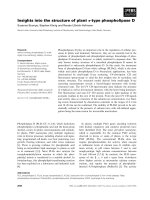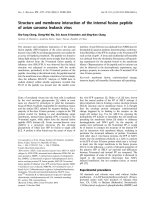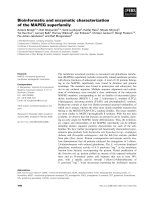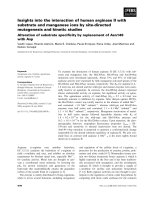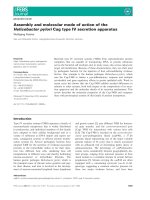Báo cáo khoa học: MicroRNAs and the regulation of fibrosis potx
Bạn đang xem bản rút gọn của tài liệu. Xem và tải ngay bản đầy đủ của tài liệu tại đây (162.27 KB, 7 trang )
REVIEW ARTICLE
MicroRNAs and the regulation of fibrosis
Xiaoying Jiang
1,2
, Eleni Tsitsiou
2
, Sarah E. Herrick
2
and Mark A. Lindsay
2
1 Department of Genetics and Molecular Biology, School of Medicine, Xi’an Jiaotong University, Shaanxi, China
2 NIHR Translational Research Facility in Respiratory Medicine Group, School of Translational Medicine, Stopford Building,
University of Manchester, UK
Introduction
MicroRNA (miRNA)-mediated RNA interference has
been identified as a novel mechanism that regulates
gene expression at the translational level [1,2]. These
short RNA sequences of 20–23 nucleotides are pro-
duced by the processing of full-length mRNA-like
transcripts known as primary miRNAs [3,4]. These
larger primary miRNA transcripts undergo enzymatic
cleavage by the RNase III Drosha to produce precur-
sor miRNAs of 70 nucleotides. These are then trans-
ported to the cytoplasm where they are further
processed by another RNase III enzyme, dicer, to
produce double-stranded RNAs of 21–23 nucleotides.
One strand, the mature miRNA, is then loaded into
the RNA-induced silencing complex where it is
believed to either repress mRNA translation or reduce
mRNA stability following imperfect binding between
the miRNA and the miRNA-recognition elements
(MRE) within the 3¢-UTR of target genes. Specificity
of the miRNA is thought to be primarily mediated by
the ‘seed’ region that is localized between residues 2
and 8 at the 5¢ end [5–7].
In most circumstances, miRNAs are believed to
either repress mRNA translation or reduce mRNA sta-
bility following imperfect binding between the miRNA
and the MREs within the 3¢-UTR of target genes. The
specificity of the miRNA guide strand is thought to be
mediated by the ‘seed’ region localized between resi-
dues 2 and 8 at the 5¢ end [5–7], and the specificity also
appears to be influenced by additional factors such as
the presence of, and cooperation between, multiple
MREs [8,9], the spacing between MREs [9,10], proxi-
mity to the stop codon [9], the position within the
Keywords
collagen; extracellular matrix molecules;
fibroblasts; fibrosis; microRNA (miRNA)
Correspondence
Xiaoying Jiang, Department of Genetics and
Molecular Biology, Medical College of Xi’an
Jiaotong University, 76 Yanta West Road,
Xi’an 710061, Shaanxi, China
Fax: +86 2987864621
Tel: +86 2982657013
E-mail:
(Received 19 November 2009, revised 1
February 2010, accepted 2 March 2010)
doi:10.1111/j.1742-4658.2010.07632.x
MicroRNAs (miRNAs) are small, noncoding RNAs of 18–25 nucleotides
that are generally believed to either block the translation or induce the deg-
radation of target mRNA. miRNAs have been shown to play fundamental
roles in diverse biological and pathological processes, including cell prolif-
eration, differentiation, apoptosis and carcinogenesis. Fibrosis results from
an imbalance in the turnover of extracellular matrix molecules and is a
highly debilitating process that can eventually lead to organ dysfunction.
A growing body of evidence suggests that miRNAs participate in the fibro-
tic process in a number of organs including the heart, kidney, liver and
lung. In this review, we summarize our current understanding of the role
of miRNAs in the development of tissue fibrosis and their potential as
novel drug targets.
Abbreviations
CTGF, connective tissue growth factor; ECM, extracellular matrix; ERK, extracellular regulated kinase; FGF, fibroblast growth factor; HSC,
hepatic stellate cell; miRNA, microRNA; MMP, matrix metalloproteinase; MRE, miRNA-recognition element; PI3K, phosphoinositol 3-kinase;
PTEN, phosphatase and tension homolog; TGF-b, transforming growth factor-b; TNF-a, tumor necrosis factor-a.
FEBS Journal 277 (2010) 2015–2021 ª 2010 The Authors Journal compilation ª 2010 FEBS 2015
3¢-UTR [9], the AU composition [9] and the target
mRNA secondary structure [11]. However, recent stud-
ies have also suggested that miRNAs might enhance
mRNA translation in nonproliferating or amino-acid
starved cells. Thus, serum starvation and cell-cycle
arrest was shown to increase tumor necrosis factor-a
(TNF-a) release by a mechanism that involved the
binding of miRNA-369-3 to the AU-rich elements
within the 3¢-UTR of TNF-a and the interaction
between two miRNA-induced silencing complex-associ-
ated proteins, Ago 2 and fragile-X-mental-retardation-
related protein 1 (FXR1) [12,13]. In similar studies,
Orom et al. [14] have demonstrated that miRNA-10a
increases ribosomal protein expression following amino
acid starvation and in response to cellular stress. In
this case, the action of miRNA-10a was shown to be
mediated through binding within the 5¢-UTR (and not
the 3¢-UTR) of mRNA at regions immediately down-
stream of the regulatory 5¢-TOP motif [14]. It therefore
appears that although miRNAs predominately repress
translation through binding within the 3¢-UTR of tar-
get mRNA, individual miRNAs might also increase
mRNA translation and bind regions within the
5¢-UTR.
There is now overwhelming evidence that miRNAs
regulate diverse biological processes including cell pro-
liferation, differentiation and apoptosis, and that aber-
rant miRNA expression ⁄ action can lead to the
development of multiple diseases. Fibrosis is character-
ized by the excess deposition of extracellular matrix
(ECM) components, which is the end result of an
imbalance of metabolism of the ECM molecule. Irreg-
ularities in multiple pathways involved in tissue repair
and inflammation can lead to the development of
fibrosis. Collagens are the predominant ECM proteins,
while other ECM proteins such as fibronectins, elastin
and fibrillins also have an important role in the devel-
opment of fibrosis [15]. Fibrosis is likely to result from
both an increased synthesis and decreased degradation
of ECM components. In particular, matrix metallopro-
teinases (MMPs) that degrade the ECM may be
up-regulated, while their inhibitors, tissue inhibitor of
metalloproteinases, may be down-regulated. Collagens
are synthesized by many cell types, but mainly by mes-
enchymal cells, including fibroblasts. Following tissue
injury, fibroblasts differentiate into myofibroblasts
and, often, persistent activation of the myofibroblast
phenotype with a resistance to apoptosis ensures the
development of fibrosis. A number of profibrotic medi-
ators have been identified, and transforming growth
factor-b (TGF-b) is proposed to play a central role in
many fibrotic conditions. Extensive tissue remodeling
and fibrosis can ultimately lead to failure of a number
of organs. Although current treatments typically target
the inflammatory response, the mechanism of fibrosis
is poorly understood and there are few effective thera-
pies. For these reasons, and knowing the multitude of
pathways that miRNAs can affect, it is envisaged that
investigating the roles of miRNAs in fibrosis could not
only advance our understanding of the pathogenesis of
this common condition, but might also provide new
targets for therapeutic intervention. In this regard, we
have reviewed the growing body of evidence which
suggests that miRNAs are involved in the process of
fibrosis in several organs, including heart, lung, kidney
and liver (Fig. 1).
miRNA and cardiac fibrosis
Cardiac fibroblasts are the most numerous cell type in
the heart and are central to the regulation of cardiac
ECM metabolism [16]. Excess deposition of ECM
components in the heart is associated with numerous
cardiovascular diseases, including hypertension, myo-
cardial infarction and cardiomyopathy, and there is
now accumulating evidence that implicates miRNAs in
the modulation of these conditions [17–21].
The overall importance of miRNAs was shown by
Da Costa Martins et al. [22], who reported that condi-
tional deletion of dicer (an enzyme that is central to
miRNA metabolism) in the mouse myocardium
resulted in cardiomyocyte hypertrophy and remarkable
ventricular fibrosis. Subsequent articles have helped to
clarify the roles of individual miRNAs in cardiac fibro-
sis. Using in situ hybridization, Thum et al. [23] found
that miR-21 was selectively expressed in cardiac fibro-
blasts and that miR-21 expression was greatly
enhanced in the failing heart in human, mice and rats.
Subsequent mechanistic studies of rat cardiac fibro-
blasts showed that increased miR-21 expression
enhanced extracellular regulated kinase (ERK) signal-
ing by targeting the down-regulation of the ERK
inhibitor, sprouty homolog 1 (Spry1). In turn, this pro-
moted fibroblast survival and fibroblast growth factor
(FGF) secretion, leading to fibroblast proliferation and
ECM ⁄ collagen deposition in vitro [23]. Significantly,
in vivo silencing of miR-21 using an ‘antagomir’ was
shown to reduce cardiac ERK kinase activity and inhi-
bit interstitial fibrosis and cardiac dysfunction in a
mouse mode of cardiac hypertrophy induced by over-
loaded pressure [23]. Increased expression of miR-21
has also been demonstrated in the infarct zone of
hearts subjected to ischemia-reperfusion, especially in
cardiac fibroblasts [24]. Under these circumstances,
increased miR-21 expression was shown to target the
down-regulation of phosphatase and tension homolog
miRNAs and fibrosis X. Jiang et al.
2016 FEBS Journal 277 (2010) 2015–2021 ª 2010 The Authors Journal compilation ª 2010 FEBS
(PTEN), which negatively regulates the phospho-
inositol 3-kinase (PI3K)-Akt signaling pathway [24].
The subsequent activation of the PI3K-Akt pathway
increased the expression of matrix metalloproteinase-2,
which is known to degrade ECM and permit the
infiltration of fibroblasts [24].
The miR-29 family has also been implicated in
cardiac fibrosis following a report showing down-
regulation of the miR-29 family members (miR-29a,
miR-29b and miR-29c) in the border zone of murine
and human hearts during myocardial infarction [25].
This study also showed down-regulation of miR-149
and increased expression of miR-21, miR-214 and
miR-223, although the functional consequences of
these changes are unknown. Multiple target genes of
the miR-29 family were identified, including ECM pro-
teins such as collagens, fibrillins and elastin, and it was
speculated that TGF-b-mediated down-regulation of
miR-29 would enhance fibrosis. This was confirmed by
demonstrating decreased collagen expression in
cultured mouse cardiac fibroblasts transfected with
miR-29b mimics and increased collagen expression in
mouse liver, kidney and heart following the adminis-
tration of a cholesterol-modified inhibitor by tail vein
injection [25].
Connective tissue growth factor (CTGF) is known
to be a potent inducer of tissue fibrosis in multiple
tissues, including the heart. Interestingly, Duisters
et al. [26] have shown that miR-133 and miR-30 target
the down-regulation of CTGF expression in cultured
rat cardiomyocytes and fibroblasts. Investigations
using rodent models of cardiac hypertrophy and sam-
ples from patients with left ventricular hypertrophy
showed a reduction in miR-30 and miR-133 expression
that was inversely correlated with CTGF, collagen and
fibrosis levels [26]. The potential importance of miR-
133 has been underlined by reports that miR-133-a1
and miR-133-a2 knockout mice develop severe fibrosis
and heart failure [27] and by studies showing that
miR-133 and miR-590 are down-regulated in a canine
model of nicotine-induced atrial interstitial fibrosis
[28,29]. Interestingly, mechanistic studies in the canine
models and in cultured atrial fibroblasts have shown
that the protective actions of miR-133 and miR-590
Pulmonary fibrosis
miR-155
Bleomycin instillation
KGF (FGF-7)
miR-21
Spry1
ERK
Cardiac fibrosis
PTEN/PI3K
Akt
MMP2
miR-29
Collagen
CTGF
TGFβ
TGFβ RII
miR-30
miR-133
miR-133
miR-590
Failing heart
Ischemia reperfusion
Cardiac infarction
Nicotine induced
Atrial fibrosis
Bcl-2
Caspase 3/8/9
Apoptosis
Revert to
quiescent
phenotype
Collagen
Activated hepatic
Stellate cells
miR-15b
miR-16
Proliferation
Hepatic fibrosis
miR-27a
miR-27b
retinoid X receptor α
miR-29a
miR-29b
Hepatitis C virus
Rat liver fibrosis
Renal fibrosis
Zeb2
miR-192
Collagen Akt
PTEN/PI3K
miR-216a
miR-217
Fibronectin
miR-377
p21 activated kinase
Superoxide dismutase
SOD
TGFβTGFβ
Fig. 1. Overview of the role of miRNAs in fibrosis.
X. Jiang et al. miRNAs and fibrosis
FEBS Journal 277 (2010) 2015–2021 ª 2010 The Authors Journal compilation ª 2010 FEBS 2017
are mediated through targeting the down-regulation of
TGF-b1 and TGF-b receptor type II, respectively [29].
Finally, van Rooij et al. [30] have demonstrated that
mice containing a miR-208 deletion, unlike wild-type
mice, did not exhibit cardiomyocyte hypertrophy or
fibrosis in response to aortic banding and transgenic
expression of activated calcineurin. Although deletion
of miR-208 was shown to attenuate expression of the
b-myosin heavy chain in heart tissue, the mechanism
by which miR-208 impacts on the fibrotic process is
unknown.
miRNAs and pulmonary fibrosis
Pulmonary fibrosis is characterized by excessive deposi-
tion of collagen and other ECM proteins within the
pulmonary interstitium and is commonly associated
with the up-regulation of TGF-b [31]. Little is known
regarding the role of miRNAs in lung fibrosis, although
a recent report by Pottier et al. [32], using human lung
fibroblasts, has shown that miR-155 expression was
increased following treatment with TNF-a and interleu-
kin-1b and reduced following treatment with TGF-b.
Mechanistic studies indicated that increased expression
of miR-155 down-regulates the production of keratino-
cyte growth factor (KGF, FGF-7) and increases fibro-
blast migration by inducing caspase-3 expression.
Studies using a bleomycin-induced mouse model of
lung fibrosis confirmed that the up-regulation of
miR-155 was correlated with the degree of lung fibrosis
in C57BL ⁄ 6 and BALB ⁄ c mice [32].
miRNAs and hepatic fibrosis
Fibrosis is a common outcome of chronic hepatic
diseases (including viral hepatitis, alcohol abuse and
metabolic diseases) and can ultimately lead to liver cir-
rhosis and hepatic failure. Hepatic stellate cells (HSCs)
are believed to be the main matrix-producing cells in
the liver. Following multiple injurious agents and ⁄ or
exposure to inflammatory cytokines, activated HSCs
lose their lipid droplets, migrate to injured sites and
are transformed into myofibroblast-like cells that
secrete large amounts of ECM leading finally to liver
fibrosis [33].
A number of reports have demonstrated an impor-
tant role of miRNAs during the activation of HSCs.
Thus, measurement of the changes in miRNA expres-
sion in activated rat HSCs identified 12 up-regulated
miRNAs (miR-874, -29c*, -501, -349, -325-5p, -328,
-138, -143, -207, -872, -140, 193) and nine down-regu-
lated miRNAs (miR-341, -20b-3p, -15b, -16, -375, -122,
-146a, -92b, -126) [34]. Interestingly, over-expression of
miR-16 and miR-15b was shown to inhibit HSC prolif-
eration and induce apoptosis through down-regulation
of the mitochondrial-associated anti-apoptotic protein,
Bcl-2, leading to activation of caspases 3, 8 and 9
[35,36]. In contrast to these studies, a second miRNA
expression profile performed in activated rat HSCs
showed increased expression of miR-27a and miR-27b
[37]. In this case, inhibition of miR-27a and miR-27b
reverted activated HSC back to a quiescent state, a
process that was mediated by preventing the increase
in expression of the miR-27a ⁄ b target, retinoid X
receptor a [37]. These findings show that miRNAs play
a significant role in the progression of liver fibrogenesis
via HSC activation.
Steatohepatitis resulting from chronic alcoholic
abuse or metabolic syndrome is a common liver dis-
ease that usually precedes liver fibrosis [38]. Using
two mice models of alcoholic and nonalcoholic steato-
hepatitis, Dolganiuc et al. [38] has shown changed
expression of five miRNAs: miR-705 and miR-1224
were up-regulated in both groups, whilst miR-182,
miR-183 and miR-199a-3p were down-regulated in the
alcoholic group but up-regulated in the nonalcoholic
group. At the present time, the role of these miRNAs
in the development of steatohepatitis is unknown.
As with cardiac fibrosis, reduced expression of
miR-29a and miR-29b has been demonstrated during
activation of primary rat HSCs, in biopsies of patients
with hepatitis C virus infection and in a rat model of
fibrosis induced by bile-duct ligation. This indicates
that the miR-29 family might also have an anti-fibro-
genic function in the liver, a suggestion that is sup-
ported by functional studies showing decreased
collagen synthesis in HSCs following over-expression
of miR-29 [39].
miRNAs and renal fibrosis
Renal fibrosis involving excessive deposition of ECM
in the kidney, is a common response to chronic kidney
diseases, including many kinds of nephritis, nephropa-
thy and other nephritic diseases, which eventually leads
to irreversible renal failure [40]. Diabetic nephropathy
is a common complication of diabetes and also pro-
vides a good model with which to study renal fibrosis,
showing progressive fibrosis in the renal glomerulus
and tubulo-interstitial region that correlates with the
decline of renal function [41].
Kato et al. [42] have reported that miR-192 was
up-regulated in the glomeruli of type 1 and type 2
diabetic mice and in cultured mesangial cells treated
with TGF-b1. They found that TGF-b1-induced
miR-192 expression in mesangial cells increased the
miRNAs and fibrosis X. Jiang et al.
2018 FEBS Journal 277 (2010) 2015–2021 ª 2010 The Authors Journal compilation ª 2010 FEBS
expression of collagen 1a2 by down-regulating Zeb2,
an E-box repressor [42]. In a subsequent report, this
group showed that down-regulation of Zeb2 resulted
in increased expression of miR-216a and miR-217.
This also contributed to increased collagen production
and the development of diabetic nephropathy through
the down-regulation of PTEN and the subsequent acti-
vation of Akt (Fig. 1) [43]. Increased expression of
miR-377 is also thought to regulate the expression of
fibronectin, which accumulates in diabetic nephropa-
thy. Expression of miR-377 was up-regulated in mouse
models of diabetic nephropathy and in cultured human
and mouse mesangial cells treated with high concentra-
tions of glucose and TGF-b1 [44]. Increased expression
of fibronectin was shown to result from the miR-377-
mediated down-regulation of p21-activated kinase and
superoxide dismutase [44].
Conclusion
As outlined in this review, there is now increasing evi-
dence that miRNAs regulate fibrosis in multiple organs
including the heart, lung, kidney and liver (Fig. 1). In
particular, a number of miRNAs, such as the miR-21
and miR-29 families, are emerging as common regula-
tors of fibrosis in multiple tissues and can be divided
into two groups: those that regulate the differentiation
into fibrotic cells (i.e. miR-21) and those that directly
target the translation of ECM components (i.e.
miR-29). As there are few treatment options for fibro-
sis, modulation of miRNAs using either antisense
strands that block their activity or over-expression
from viral or plasmid vectors, has been proposed as
a potentially novel therapeutic approach [45,46].
Significantly, a number of reports discussed in this
review have demonstrated the feasibility of this
approach in preclinical mouse models of fibrosis. Thus,
van Rooij et al. [25] has shown that inhibiting miR-29
using cholesterol-conjugated antisense strands
increased collagen expression in mouse liver, kidney
and heart, whilst Thum et al. [23] used a similar
approach to demonstrate that inhibition of miR-21
prevents interstitial fibrosis and cardiac hypertrophy in
a mouse model of heart infarction. However, future
developments will be crucially dependent upon under-
standing the function and mechanisms of action of
these fibrotic miRNAs.
Acknowledgements
This work was supported by the Chinese Government
Academic Exchange Programme (X.J.), National
Institute of Health Research (E.T.) and the Wellcome
Trust (grant no.: 076111; M.A.L.).
References
1 Bartel DP (2009) MicroRNAs: target recognition and
regulatory functions. Cell 136, 215–233.
2 Filipowicz W, Jaskiewicz L, Kolb FA & Pillai RS
(2005) Post-transcriptional gene silencing by siRNAs
and miRNAs. Curr Opin Struct Biol 15, 331–341.
3 Winter J, Jung S, Keller S, Gregory RI & Diederichs S
(2009) Many roads to maturity: microRNA biogenesis
pathways and their regulation. Nat Cell Biol 11, 228–
234.
4 Kim VN, Han J & Siomi MC (2009) Biogenesis of
small RNAs in animals. Nat Rev Mol Cell Biol 10, 126–
139.
5 Lewis BP, Shih IH, Jones-Rhoades MW, Bartel DP &
Burge CB (2003) Prediction of mammalian microRNA
targets. Cell 115, 787–798.
6 Doench JG & Sharp PA (2004) Specificity of microR-
NA target selection in translational repression. Genes
Dev 18, 504–511.
7 Didiano D & Hobert O (2006) Perfect seed pairing is
not a generally reliable predictor for miRNA-target
interactions. Nat Struct Mol Biol 13, 849–851.
8 Doench JG, Petersen CP & Sharp PA (2003) siRNAs
can function as miRNAs. Genes Dev 17, 438–442.
9 Farh KK, Grimson A, Jan C, Lewis BP, Johnston WK,
Lim LP, Burge CB & Bartel DP (2005) The widespread
impact of mammalian microRNAs on mRNA repres-
sion and evolution. Science 310, 1817–1821.
10 Saetrom P, Heale BS, Snove O Jr, Aagaard L, Alluin J
& Rossi JJ (2007) Distance constraints between
microRNA target sites dictate efficacy and
cooperativity. Nucleic Acids Res 35, 2333–2342.
11 Long D, Lee R, Williams P, Chan CY, Ambros V &
Ding Y (2007) Potent effect of target structure on
microRNA function. Nat Struct Mol Biol 14, 287–294.
12 Vasudevan S & Steitz JA (2007) AU-rich-element-medi-
ated upregulation of translation by FXR1 and Argona-
ute 2. Cell 128, 1105–1118.
13 Vasudevan S, Tong Y & Steitz JA (2007) Switching
from repression to activation: microRNAs can up-regu-
late translation. Science 318, 1931–1934.
14 Orom UA, Nielsen FC & Lund AH (2008)
MicroRNA-10a binds the 5¢UTR of ribosomal protein
mRNAs and enhances their translation. Mol Cell 30,
460–471.
15 Muro AF, Moretti FA, Moore BB, Yan M, Atrasz
RG, Wilke CA, Flaherty KR, Martinez FJ, Tsui JL,
Sheppard D et al. (2008) An essential role for fibronec-
tin extra type III domain A in pulmonary fibrosis. Am
J Respir Crit Care Med 2008, 638–645.
X. Jiang et al. miRNAs and fibrosis
FEBS Journal 277 (2010) 2015–2021 ª 2010 The Authors Journal compilation ª 2010 FEBS 2019
16 Souders CA, Bowers SL & Baudino TA (2009) Cardiac
fibroblast: the renaissance cell. Circ Res 105, 1164–1176.
17 van RE & Olson EN (2009) Searching for miR-acles in
cardiac fibrosis. Circ Res 104, 138–140.
18 Diez J (2009) Do microRNAs regulate myocardial
fibrosis? Nat Clin Pract Cardiovasc Med 6, 88–89.
19 Haghikia A & Hilfiker-Kleiner D (2009) MiRNA-21:
a key to controlling the cardiac fibroblast compartment?
Cardiovasc Res 82, 1–3.
20 Mishra PK, Tyagi N, Kumar M & Tyagi SC (2009)
MicroRNAs as a therapeutic target for cardiovascular
diseases. J Cell Mol Med 13, 778–789.
21 Latronico MV & Condorelli G (2009) MicroRNAs
and cardiac pathology. Nat Rev Cardiol 6, 419–429.
22 da Costa Martins PA, Bourajjaj M, Gladka M,
Kortland M, van Oort RJ, Pinto YM, Molkentin JD &
De Windt LJ (2008) Conditional dicer gene deletion in
the postnatal myocardium provokes spontaneous
cardiac remodeling. Circulation 118, 1567–1576.
23 Thum T, Gross C, Fiedler J, Fischer T, Kissler S,
Bussen M, Galuppo P, Just S, Rottbauer W, Frantz S
et al. (2008) MicroRNA-21 contributes to myocardial
disease by stimulating MAP kinase signalling in
fibroblasts. Nature 456, 980–984.
24 Roy S, Khanna S, Hussain SR, Biswas S, Azad A, Rink
C, Gnyawali S, Shilo S, Nuovo GJ & Sen CK (2009)
MicroRNA expression in response to murine
myocardial infarction: miR-21 regulates fibroblast
metalloprotease-2 via phosphatase and tensin
homologue. Cardiovasc Res 82, 21–29.
25 van Rooij E, Sutherland LB, Thatcher JE, DiMaio JM,
Naseem RH, Marshall WS, Hill JA & Olson EN (2008)
Dysregulation of microRNAs after myocardial
infarction reveals a role of miR-29 in cardiac fibrosis.
Proc Natl Acad Sci USA 105, 13027–13032.
26 Duisters RF, Tijsen AJ, Schroen B, Leenders JJ,
Lentink V, Van der Made I, Herias V, van Leeuwen
RE, Schellings MW, Barenbrug P et al. (2009)
miR-133 and miR-30 regulate connective tissue
growth factor: implications for a role of microRNAs
in myocardial matrix remodeling. Circ Res 104,
170–178.
27 Liu N, Bezprozvannaya S, Williams AH, Qi X,
Richardson JA, Bassel-Duby R & Olson EN (2008)
microRNA-133a regulates cardiomyocyte proliferation
and suppresses smooth muscle gene expression in the
heart. Genes Dev 22, 3242–3254.
28 Goette A (2009) Nicotine, atrial fibrosis, and atrial
fibrillation: do microRNAs help to clear the smoke?
Cardiovasc Res 83, 421–422.
29 Shan H, Zhang Y, Lu Y, Zhang Y, Pan Z, Cai B,
Wang N, Li X, Feng T, Hong Y et al. (2009)
Downregulation of miR-133 and miR-590 contributes
to nicotine-induced atrial remodelling in canines.
Cardiovasc Res 83, 465–472.
30 van Rooij E, Sutherland LB, Qi X, Richardson JA, Hill
J & Olson EN (2007) Control of stress-dependent
cardiac growth and gene expression by a microRNA.
Science 316, 575–579.
31 du Bois RM (2010) Strategies for treating idiopathic
pulmonary fibrosis. Nat Rev Drug Discov 9, 129–140.
32 Pottier N, Maurin T, Chevalier B, Puissegur MP,
Lebrigand K, Robbe-Sermesant K, Bertero T, Lino
Cardenas CL, Courcot E, Rios G et al. (2009)
Identification of keratinocyte growth factor as a target
of microRNA-155 in lung fibroblasts: implication in
epithelial-mesenchymal interactions. PLoS ONE 4,
e6718.
33 Henderson NC & Iredale JP (2007) Liver fibrosis:
cellular mechanisms of progression and resolution.
Clin
Sci (Lond) 112, 265–280.
34 Guo CJ, Pan Q, Cheng T, Jiang B, Chen GY & Li DG
(2009) Changes in microRNAs associated with hepatic
stellate cell activation status identify signaling pathways.
FEBS J 276, 5163–5176.
35 Guo CJ, Pan Q, Li DG, Sun H & Liu BW (2009)
miR-15b and miR-16 are implicated in activation of the
rat hepatic stellate cell: an essential role for apoptosis.
J Hepatol 50, 766–778.
36 Guo CJ, Pan Q, Jiang B, Chen GY & Li DG (2009)
Effects of upregulated expression of microRNA-16 on
biological properties of culture-activated hepatic stellate
cells. Apoptosis 14, 1331–1340.
37 Ji J, Zhang J, Huang G, Qian J, Wang X & Mei S
(2009) Over-expressed microRNA-27a and 27b
influence fat accumulation and cell proliferation
during rat hepatic stellate cell activation. FEBS Lett
583, 759–766.
38 Dolganiuc A, Petrasek J, Kodys K, Catalano D,
Mandrekar P, Velayudham A & Szabo G (2009)
MicroRNA expression profile in Lieber-DeCarli
diet-induced alcoholic and methionine choline
deficient diet-induced nonalcoholic steatohepatitis
models in mice. Alcohol Clin Exp Res 33, 1704–
1710.
39 Kwiecinski M, Strack I, Noetel A, Schivenbusch S,
Elfimova N, Dienes HP & Odenthal M (2009)
MicroRNA: antifibrogenic mediator in liver
fibrogenesis. J Hepatol 50, S110.
40 Schnaper HW & Kopp JB (2003) Renal fibrosis. Front
Biosci 8, e68–e86.
41 Brosius FC III (2008) New insights into the mechanisms
of fibrosis and sclerosis in diabetic nephropathy. Rev
Endocr Metab Disord 9, 245–254.
42 Kato M, Zhang J, Wang M, Lanting L, Yuan H,
Rossi JJ & Natarajan R (2007) MicroRNA-192 in
diabetic kidney glomeruli and its function in
TGF-beta-induced collagen expression via inhibition
of E-box repressors. Proc Natl Acad Sci USA 104,
3432–3437.
miRNAs and fibrosis X. Jiang et al.
2020 FEBS Journal 277 (2010) 2015–2021 ª 2010 The Authors Journal compilation ª 2010 FEBS
43 Kato M, Putta S, Wang M, Yuan H, Lanting L, Nair
I, Gunn A, Nakagawa Y, Shimano H, Todorov I et al.
(2009) TGF-beta activates Akt kinase through a
microRNA-dependent amplifying circuit targeting
PTEN. Nat Cell Biol 11, 881–889.
44 Wang Q, Wang Y, Minto AW, Wang J, Shi Q, Li X &
Quigg RJ (2008) MicroRNA-377 is up-regulated and
can lead to increased fibronectin production in diabetic
nephropathy. FASEB J 22, 4126–4135.
45 Brown BD & Naldini L (2009) Exploiting and
antagonizing microRNA regulation for therapeutic
and experimental applications. Nat Rev Genet 10,
578–585.
46 van Rooij E, Marshall WS & Olson EN (2008) Toward
microRNA-based therapeutics for heart disease: the
sense in antisense. Circ Res 103, 919–928.
X. Jiang et al. miRNAs and fibrosis
FEBS Journal 277 (2010) 2015–2021 ª 2010 The Authors Journal compilation ª 2010 FEBS 2021





